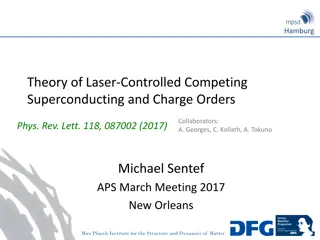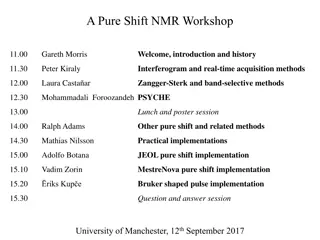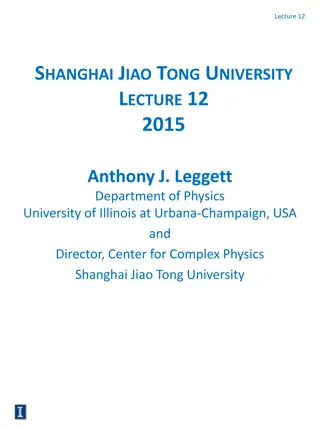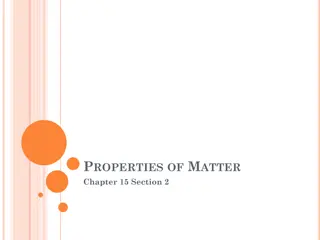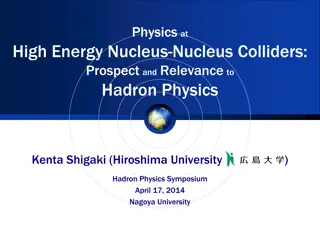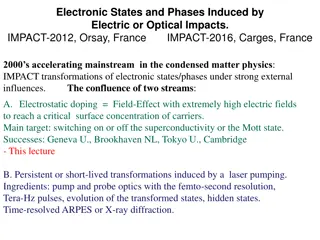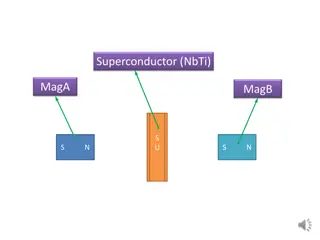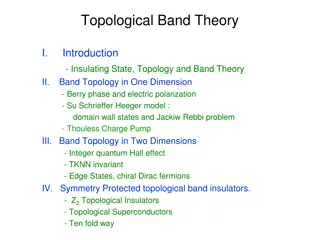Superconductivity Properties and Behaviors
Properties of superconductors are explored based on their shape and connectivity, revealing insights into surface currents, magnetic moments, and boundary conditions. The significance of simply connected regions in superconducting materials is demonstrated, highlighting unique phenomena and characteristics. This analysis delves into the implications of different shapes and configurations on superconductivity, shedding light on fundamental principles governing these materials.
Download Presentation

Please find below an Image/Link to download the presentation.
The content on the website is provided AS IS for your information and personal use only. It may not be sold, licensed, or shared on other websites without obtaining consent from the author.If you encounter any issues during the download, it is possible that the publisher has removed the file from their server.
You are allowed to download the files provided on this website for personal or commercial use, subject to the condition that they are used lawfully. All files are the property of their respective owners.
The content on the website is provided AS IS for your information and personal use only. It may not be sold, licensed, or shared on other websites without obtaining consent from the author.
E N D
Presentation Transcript
Superconductivity Current Section 54
1. Properties of superconductors that depend on their shape A simply connected region or domain is one in which every closed contour in that region encloses only the points contained in it (the region). If a region is not simply connected, it is called multiply connected. As an example of a multiply connected region, consider the z-plane with the interior of the unit circle excluded, since the unit circle is a closed contour within the region that encloses points that are not part of the region. The region is shaded pink. The unit circle is a contour that encloses points that are not part of the region
2. A simply-connected superconductor can have no steady surface current in the absence of an externally-applied magnetic field. Proof Suppose otherwise: A simply connected superconductor that is the only object in the universe, and it has steady surface currents on it. This H-field vanishes at infinity. These steady currents must generate a steady H-field outside the body. Curl H = 0 in vacuum in steady state, so H is a potential field. Div H= 0 in vacuum, so potential satisfies Laplace s equation.
Boundary of superconductor: Bn = 0, means Hn = 0 in the vacuum just outside. And Magnetic scalar potential must equal the same constant at all points outside, or else a radial component of H would appear exclusively at points far from any currents.
In spherical coordinates, = 0 has solutions that are powers of r: r , where can be positive or negative. If d /dr is zero at both r = a and r = infinity, the only possible value of is zero. Then d /dr = 0, giving Hr = 0 at all r: = the same constant at all r. An H-field of this kind cannot exist. Supposition is false: There can be no steady current on a simply connected body.
3. For a simply-connected body in an external -field, a magnetic moment appears, signature of surface currents. 4. Susceptibility is diamagnetic and has value -1/4 for any simply connected shape. We show it for a long needle shape. Long superconducting cylinder Generated by other current distributions. Continuity of Ht holds even in the presence of surface currents (sec 29,30). For this long-cylinder geometry, H-field inside superconductor Original external field.
B = 0 inside superconductor. Magnetization The total magnetic moment still has meaning and is given by Diamagnetic volume susceptibility of a superconductor is -1/4 But still no net current through any cross section for simply connected body
7. Multiply connected superconductor A ring is doubly connected. Surface currents need not balance out, giving total superconductivity current J, even without an externally applied emf. The field of the ring is a potential field H = -grad where is many valued.
Circulation of field around any contour that encloses the loop. Open surface that spans the ring, e.g. a soap film Values of potential on opposite sides of the surface. Such a problem has a solution to Laplace Equation
A magnetic field of this kind can exist, and so can the assumed surface currents.
Magnetic flux through ring does not depend on the thickness of the wire. Flux is same for any surface spanning the ring. Total magnetic energy = Div H = 0, since H = B outside and div B = 0.
Integration surface comprises The surface at infinity The surface of the ring The two sides of surface C. H is zero here. Hn is zero here.
Integral over surface C From the definition of self inductance
Flux from field of current on ring Flux from external field For a superconducting ring in an external magnetic field, the total flux = Follows from Maxwell s equations
E = zero inside a superconductor Et is continuous at surface. Tells how J changes if the external magnetic field changes.





